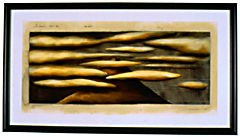

by Jón Proppé
There is a strong tradition of landscape painting in Iceland, but although mountains, cliffs and lava have thus been a popular motif, few landscape painters have tried to capture any sense of the formation of the landscape that they paint. The mountains in these paintings stand heavy and complete, eternal in opposition to the fleeting reality of the human world. Set against nature -- these paintings tell us -- we are small and fragile. We do not know the future and remain incomplete, forever wandering the world looking to fill some need that we hardly recognise ourselves. The mountains and the stones are a constant reminder of our imperfection. Their tomorrow is like their yesterday. They remain free of time.
Yet it is the evidence of the land’s formation that first strikes us as we travel through the Icelandic landscape and the Icelanders themselves have always been acutely aware of the land’s ever-changing character. They have seen mountains burn and lava flow forth to fill valleys and cover whole counties or raise new islands from the sea. From earliest times the Icelanders have accepted these rumblings with equanimity. They seem to have shown no fear and they have not been tempted to mythologise the lava and the eruptions; there is remarkably little folklore to be associated with volcanoes. On the contrary, they seem to have viewed this infernal activity as quite a normal -- almost humdrum -- feature of nature, like the cycles of sunrise and sunset or the passing of the seasons. Rather than standing awe-struck or concocting myths to explain the often destructive expulsions of lava and poisonous gas, they sought to record and understand. The old annals contain only the most prosaic -- often quite terse -- entries: 1206 ‘The third fire of Heckelfell’; 1222 ‘The fourth fire of Heckelfell’. This writer, the author of Konungsannáll or the King’s Annal, seems to have been primarily concerned to keep the record and to retain a historical perspective that might allow an overview of the mountain’s stirrings.
The Icelander’s attitude to the mountains is strikingly untouched by mystical speculation, showing rather a healthy curiosity about their history and underlying causes. The first natural historians wrote extensively about the volcanoes and their manuscripts can be glimpsed in the background of some of Arngunnur Yr’s paintings. Latter-time geologists leave different manuscripts -- the machine-writing of the seismograph that records even the faint tremors that we ourselves are unaware of -- and these, too, Arngunnur has incorporated into her pictures. On top of such data she paints the mountains and the craters themselves, using delicate strokes and warm colours that testify to the fire beneath the surface -- ochres with tinges of sulphuric yellow.
This treatment of the mountain in effect turns landscape painting on its head. The mountain no longer stands as immutable reality, untouched by our human and quotidian meandering -- our petty worries and pathetic, fleeting concerns. Even the mountain has a history and a life; it is as fleeting as we are though its life is lived to a different and much slower rhythm.
By emphasising formation and change in the landscape, Arngunnur infuses her paintings with new dimensions: the dimensions of time and growth, becoming and destruction. The time of the mountain parallels our human time and becomes a narrative. Our documentation of its eruptions and our theories on their context and causes become the mountain’s history. The mountains become human as they enter human history and are incorporated into the perspective that only time-bound beings such as ourselves can have -- the perspective of history, science and the compounded experience of generations passed on in narrative. Thus our relationship with the mountains is reversed. Mountains come and go, belch forth and erode, but we are eternal, watching their passing like Olympian gods.
In this way our relationship to nature appears as a shifting perspective -- somewhat like op-art where one sees now this now that. The trick to understanding such a relationship is to always remember that to each image there is an opposite. The larger picture can only be seen if we manage to reconcile the different perspectives and make them all our own.
Arngunnur Yr’s paintings are a bold attempt at capturing on canvas quite a complex world-view. They are indeed an ode to nature -- to Iceland’s burning nature, as Saxo the grammarian called it -- and yet they are first and foremost a confirmation of our own role in nature. We are not merely a part of nature, on par with the stones and the mountains, for we are capable of granting nature a meaning that it could otherwise never achieve. We are not intruders in the eternal world of the mountains, but rather its motive force. Our everyday awareness of them makes them blue, majestic, awe-inspiring and beautiful. Our considered reflection infuses them with a history and life that is like our own.
Introduction to an exhibition catalogue for artist Arngunnur Yr Gylfadóttir, 1996.
Oil and vax on canvas 70 x 200cm

Oil and vax on wood 89 x 210cm

Oil and vax on canvas 70 x 200cm

Oil on seismic print 62 x 114cm

Oil on seismic print 62 x 114cm
|
|
|
|
|
|
|
|